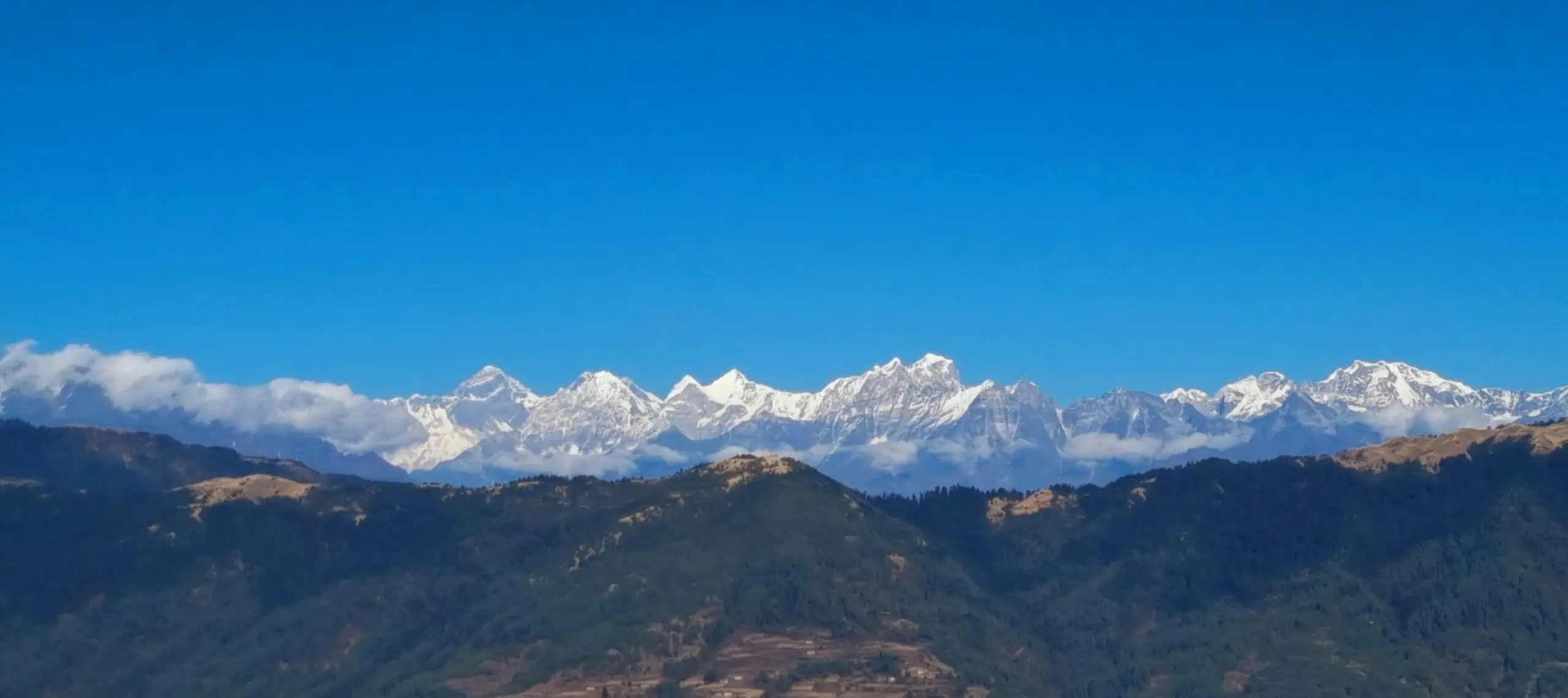
Annapurna Sanctuary Trek 16 Days
USD 1,199
USD 1,150 per person
| Activities | - | Fitness Level | Moderate |
| Max Elevation | 4130m | Commute | Kathmandu to Pokhara |
| Best Month | Autumn,Spring,winter | Group Size | Min: 2, Max: 10+ |
| Arrival on | Kathmandu | Depart From | Kathmandu |
| Meal | B L D | Duration | 16 Days |
| Stay | Hotel & Tea House | Price | USD 1,150 per person |
Annapurna Sanctuary Trekking is incredibly spectacular, set under the shade of majestic peaks Annapurna I (8091 m), Annapurna South (7219 m), Machapuchhre (6993 m) and Hiunchuli (6441).
Mt. Annapurna (8091m) is the 10th highest mountain in the world and the journey to its
base camp
(4130m/13582 ft) provides unbeatable experiences of panoramic views of mountains
that includes Annapurna 1, Annapurna South, Gangapurna, Machhapuchhare the fishtail peak, Hiunchuli and other peaks rising above 7000 and 8000 meters.
Annapurna Sanctuary Trek is one of the best selling trek in Nepal which
encounters more than 50% of overall tourist visit in Annapurna Region every years.
The Ghorepani Poonhill (3210m), Landruk village, Annapurna Base Camp (4130m) and Jhinu(Natural hot spring) are a major attraction of this trek.
In addition, if you have limited time and wish to enjoy natural beauties, enhance cultural experiences; you could join our Annapurna Base Camp Trek-14 Days or even Short Annapurna Base Camp Trek. You could also join our challenging trekking route to Annapurna Region by joining our Round Annapurna Trek-19 Days. If you are not satisfied with this itinerary or if you want to customize this package in your timeline or budget, then you could contact us, or email to [email protected]
Outline Itinerary:
Day 01: Arrival day in Kathmandu (1350m/4428 ft) (Meal: Dinner)
Day 02: Free Day in kathmandu; Option for Cultural tour in Kathmandu (1350m/4428 ft) (Meal: Breakfast)
Day 03: Drive to Pokhara, transfer to Hotel ( 823 m/2710 ft) Drive: 5/6 hrs. (Meal: Breakfast)
Day 04: Drive to Phedi and trek to Dhampus (1650 m/5577 ft) Drive: 30 minutes and trek 2-3 hrs. (Meal: BLD)
Day 05: Trek from Dhampus to Landruk ( 1646m/5530 ft) Trek: 4-5 hrs. (Meal: BLD)
Day 06: Trek from Landruk to Chhomrong (2170m/7293 ft) Trek: 5-6 hrs. (Meal: BLD)
Day 07: Trek Chhomrong to Dovan ( 2,600m/8580 ft) Trek: 6-7 hrs. (Meal: BLD) Day 08: Trek Dovan to Machhapuchhre Base Camp (3700m/12210 ft) Trek: 3-4 hrs. (Meal: BLD)
Day 09: Trek to Annapurna Base Camp (4130m/13582 ft) Trek: 3-4 hrs. (Meal: BLD) Day 10: Trek back to Himalaya (2873m/9423 ft) Trek: 5-6 hrs. (Meal: BLD)
Day 11: Trek back to Chhomrong (2170m/7118ft) Trek: 4-5 hrs. (Meal: BLD)
Day 12: Trek from Chhomrong to Tadapani (2600m/8528 ft) Trek: 5-6 hrs. (Meal: BLD)
Day 13: Trek from Tadapani to Ghorepani (2800m/9156 ft) Trek: 4-5 hrs. (Meal: BLD)
Day 14: Early Morning Excursion to Poon Hill (3210 m/10531 ft), Trek to Tirkedhunga (1577m/5157 ft) Trek: 5-6 hrs. (Meal: BLD)
Day 15: Trek to Nayapul and drive back to Pokhara (823 m/2691 ft) Trek: 4-5 hrs. Drive: 1 hrs. (Meal: BL)
Day 16: Flight /drive back to Kathmandu (1350/4428 ft) (Meal: B/D)
Day 17: Departure (1350/4428 ft) (Meal:Breakfast)
Trip Notes in Detail :
As you are trekking in the remote Himalayas of Nepal, where weather condition, health and fitness of the participants, natural calamities and any other unforeseen circumstances could compel the trip to be customized even at last minute. Hence, we always suggest to be flexible with the condition. Also, we will try our best to keep the original itinerary. Your safety and satisfaction of the trip is our prime concern while travelling with us and we ensure you our best team, logistics, professional services to make sure that you would have an amazing trip of lifetime with us. Also note that our trip leader deserved the final decision if the trip has to amend, change the route or cancel due to the extreme conditions for the safety precaution. However, he will try his best to ensure that the trip runs accordingly to the stated plan but be prepared for flexibility if necessary.
Costs
What is included?
🟢Airport transfer by Hiking Nepal office representative in a private vehicle
🟢Welcome Dinner at Typical Nepalese Restaurant with cultural dance show
🟢Farewell Dinner at finest restaurant in Thamel Kathmandu
🟢3 Nights’ accommodation at Tourist Standard Hotel in Kathmandu with breakfast on twin sharing basis
🟢11 Nights' accommodation at well and comfortable Mountain Lodge available en-route during trek (Few nights’ at during trek with attached bathroom/toilets)
🟢2 night’s accommodation at 3 star Hotel in Pokhara with breakfast on twin sharing basis
🟢Full board meal during trek (Breakfast, Lunch, Dinner, tea & coffee, seasonal fruits, chocolate/s & biscuits)
🟢English speaking, First Aid and Eco-trained local trekking guide, Assistance guide as per the group size, porters (2:1)
🟢All the expenses for guide and porters along with Insurance
🟢Kathmandu/Pokhara/Kathmandu transfer in a Tourist Bus
🟢Pokhara/Phedi and Nayapul/Pokhara transfer in a private vehicle
🟢Annapurna Conservation Area Project (ACAP) fee
🟢Trekkers’ Information Management System (TIMS) Card fee
🟢Exclusive medical kit bag, Duffle Bag, Trekking T-shirt, Trekking Maps, Adventure Certificate
🟢Sleeping Bag and Down Jacket during Trek
🟢All government and local taxes as applicable
What is not included?
🔴Nepal Visa - (Cost- US$- 30 for 15 days & $- 50 for 30 days)
🔴Lunch & evening meals while in Kathmandu (Except welcome/farewell dinner)
🔴Travel insurance
🔴Cost of personal nature expenses, Beverages (Mineral water or coca-cola), cost of extra meals, snacks, phones bills, Internet, WiFi, laundry etc.
🔴The cost incurred during emergencies, evacuations
🔴Tips for Guide/porters/driver …
DETAILED ITINERARY
Day 1: Arrive Kathmandu International Airport (Altitude: 1350/4428 ft. Meal: Dinner)-
On your arrival in Kathmandu International Airport, one of our representative will pick up you and escort you to the hotel as well as help you to check-in at hotel. After your refreshment, you will be briefed about the next day trip. In the evening, we, the Hiking Nepal will offer you a welcome dinner introducing Nepalese cuisine and culture.
Day 2: Free day in Kathmandu; Option for Cultural tour in Kathmandu (Altitude: 1350/4428 ft. Meal: Breakfast)-
Usually, we keep day 2 as rest considering the group late arrival in Kathmandu and long travel. If you wish you can you this day for sightseeing of Cultural heritage Site of Kathmandu Valley. In case of sightseeing tour, after your delightful breakfast, you will be introduced with guide and takes you to UNESCO Heritages sites of the valley where you will observe living heritage of Medieval Nepal – Witness the biggest Hindu temple of Nepal, Pashupatinath and capture the sacred moments of Hindu death ritual at Aryaghat in Pashupatinath. Stroll the lively streets of Kathmandu Old Market Asan to Kathmandu Durbar Square and visit the home of The Living Goddess Kumari, Nepalese style of Architecture as well as astonishing wooden carving. A short drive from Kathmandu Durbar Square will take you to a hill top stupa called as “Swyambhu” meaning “self -emerge” and belief that the hill emerged impulsively from the great lake that once covered Kathmandu valley.
Day 3: Drive to Pokhara, transfer to Hotel (Altitude: 823 m/2710 ft. Drive: 5/6 hrs. Meal: Breakfast)-
Early morning, after breakfast, catch Tourist bus or we can also organize a private vehicle for you. Viewing countryside villages, farm, shops and river, you will reach at Pokhara. A beautiful place with tremendous views of mountains and lakes. You can also go for Boating at Fewa Lake. Overnight at Hotel.
Day 4: Drive to Phedi, trek to Dhampus (Altitude: 1650 m/5577 ft.; Drive: 30 minutes , trek 2-3 hrs. Meal: BLD)-
After having breakfast at Hotel in Kathmandu, our guide and driver will receive you for drive to Phedi. You can view the mountains, forest and scattered village settlements. It will takes around 6/7 hours’ to reach Phedi, from where, you will hike up to Dhampus. You will walk through lush forest and beautiful landscape to the hilltop village Dhampus. From here, you can see the mesmerizing mountains including Annapurna South, Fishtail (Macchapucchre), Hiunchuli and Lamjung. Overnight at local lodge.
Day 5: Trek to Landruk (Altitude: 1,646m/5530 ft. Trek: 4-5 hrs. Meal: BLD)-
Taking picturesque views of the mountains, ascend through the forest trail that are paved with stones making somewhere a bit steeper. Following narrow path, you pass Pothana then reach Deurali. It is aplace where you find yourself in high up of the East Modi River flowing down the Annapurna Circuit surrounded by complete ambience of nature. You will reach at typical Gurung Village Landruk from where, the splendid views of Annapurna South and Hiunchuli can be grasp. Spend overnight at local lodge.
Day 6: Trek to Chhomrong (Altitude: 2,170m/7293 ft. Trek: 5-6 hrs. Meal: BLD)-
Today, you will walk along the stone steps mountain path, cross a new bridge towards the dense forest of bamboo. At this time, you will experience yourself in a complete isolation in the tranquility of nature. You will stop at Jhunu for a short rest, then headed towards Chhomrong. It is located on a steep hillside with few shops, several tea-houses and wooden cottage lodges. From here, you can have impeccable and awe-inspiring view of Mt. Macchapucchre. Overnight at Local lodge.
Day 7: Trek to Dovan (2,600m) (Altitude: 2,600m/8580 ft. Trek: 6-7 hrs. Meal: BLD)-
Today, you will walk along terrace village and farm fields descending to the Chhomrong River, then crossing a bridge, walk uphill to Sinuwa. Then onwards, you will enter to the dark and thick forest of Rhododendron till Khuldighar. Now, you will follow a long and steep steps downhill trail crossing Bamboo, oaks and Rhododendron forest towards Bamboo. From here, you will walk a short while to reach Dovan where you will stay overnight.
Day 8: Trek to Machhapuchhre Base Camp (Altitude: 3,700m/12210 ft. Trek: 3-4 hrs. Meal: BLD)-
Climbing steeply for a while on a rocky trail through the forest, you will reach at Hinko cave. From here, you will encounters several gorge and avalanche track till Daurali, where you will take rest and have lunch. Following the trail to the Sanctuary crossing avalanche path, ascend toward the Macchapucchre base camp, a grassy moraine platform with several lodges. Allowing time, you can go to ridge to grasp the picturesque views of Annapurna I, Annapurna III, Gangapurna and Macchapucchre.
Day 9: Trek to Annapurna Base Camp (Altitude: 4130m/13582 ft. Trek: 3-4 hrs. Meal: BLD)-
A charming day of Sanctuary trip is when you reach at Annapurna base Camp. It will be a short but exciting walk in a fairly gentle ascent trail to Annapurna South Base Camp. An impressive views of picturesque landscape and snowcapped Himalayas surrounding you really feels amazing. Remaining time you can explore as you wish. Overnight at local lodge.
Day 10: Trek back to Himalaya (Altitude: 2,873m/9423 ft. Trek: 5-6 hrs. Meal: BLD)-
Spend your time enjoying sunrise view over the Himalayas, then retrace your journey back to Himalaya. It will be the steep downhill walk passing through the forest to the lodge at Himalaya. Take rest and enjoy the refreshing surrounding. Overnight at local lodge.
Day 11: Trek back to Chhomrong (Altitude: 2,170m/7118ft. Trek: 4-5 hrs. Meal: BLD)-
It will be a downhill walk following the Modi River and crossing green forest, you have to cross a suspension bridge to Bamboo. Then, climbing steep ups and down trail in a forested area, you will reach at Chhomrong. You will just pass a bridge and spend your overnight at local lodge.
Day 12: Trek to Tadapani (Altitude: 2,600m/8528 ft. Trek: 5-6 hrs. Meal: BLD)-
It is an alternative route to Pokhara via Ghorepani. You will walk in a flatland, pass by forest and terraced field for a while. Then crossing a suspension bridge, you climb steep uphill enjoying the rhododendron forest to Tadapani. It is an ideal vintage point to grasp a perfect view of Annapurna South, Hiunchuli and Macchapucchre.
Day 13: Trek from Tadapani to Ghorepani( Altitude 2870m) 5-6 Hrs walking
Day 14: Trek to Ghorepani (Altitude: 2,800m/9156 ft. Trek: 4-5 hrs. Meal: BLD)-
Enjoying the majestic snowcapped mountains, lush vegetation and rich flora, you will climb in a steep trail. Catching a trail decorated with rhododendron forest will takes you to a small hamlets and cultivated land known as Deurali. From here, you will gently walk for around 3 hours to reach Ghorepani. You can have a panoramic view of Mt. Dhaulagiri range. Spend overnight at local lodge.Wake up early morning and make your journey to Poon Hill. It is a perfect place for sunrise view over the snowcapped mountainous peaks. Walking for an hours in steep uphill really amaze you when you grasp eye-popping view of mountains in the north turning yellowish color step by step by the strike of sun rays over the snowcapped top. Just returning back to lodge, get ready to make your journey to Tirkhedhunga. You will walk in a gentle trail till Ulleri and rest for a while. Then, follow the stone paved path downhill till Tirkhedhunga where you will spend your overnight.
Day 15: Trek to Nayapul via Birethanti and drive back to Pokhara (Altitude: 823 m/2691 ft. Trek: 4-5 hrs. Drive: 1 hrs. Meal: BL)-
It will be a short walk and a final day of your trek. Just walking for a while, you will reach at Birethanti, where you can stay for a while and takes some snacks. Further walk till Nayapul to catch vehicle to return back to Pokhara. After Check-in at hotel, take your time for self-exploration and leisure. Overnight at Hotel.
Day 16: Fly /drive back to Kathmandu (Altitude: 1350/4428 ft. Meal: B/D)-
Now, it’s a time to return back to Kathmandu. You can either fly or drive back to Kathmandu. Spend your time as you like. Evening time, we invite you for farewell dinner at authentic restaurant. You can share your experience, feedback us and give us a chance to make your evening a wonderful time. Overnight at Hotel.
Day 17: Departure (Altitude: 1350/4428 ft. Meal: Breakfast)-
It is a last day with us. Our supporting team will takes you to airport for your final departure. We hope to see you again. Additionally, if you have plan of any adjoining trip, you can let us to organize.
DEPARTURE DATES
| START DATE | END DATE | STATUS | PRICES |
|---|---|---|---|
| 14th Oct | 30th Oct | Limited Seats |
$ 1,150
|
| 17th Oct | 2nd Nov | Limited Seats |
$ 1,150
|
| 21st Oct | 6th Nov | Limited Seats |
$ 1,150
|
| 25th Oct | 10th Nov | Limited Seats |
$ 1,150
|
| 30th Oct | 15th Nov | Limited Seats |
$ 1,150
|
FAQ
No FAQs available for this tour.
REVIEWS
RELATED TRIPS

Sunder Peak Trek
Sunder Peak, a short trekking in the Everest Region follows the traditionally and historically impor...
More Details
Pikey Peak Trek
Pikey Trek- short and outstanding trekking to the Himalayas viewing the stunning Himalayas including...
More Details
| 1 person | 2-7 person | 8+ person |
|---|---|---|
|
$ 1,150
Partial Pay
|
$
1,099
/ per
Partial Pay
|
$
999
/ per
Partial Pay
|




- Speak to one of our travel consultants
- Call Us (24/7) : +977 9802342080
-
 WhatsApp (24/7) : +977-9802342080
WhatsApp (24/7) : +977-9802342080
Planning a Trip?
We have a pool of travel experts working in this industry for more than a decade. Consult to get started
BOOK A CALL
